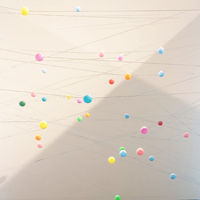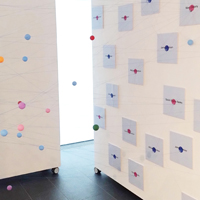Ordering the World 2
In Ordering the World 2, the archive is reimagined as a spatial network map which questions distinctions between central and peripheral figures, and challenges structures that prioritise major figures and singular achievements, one that recognises the contributions of other players, and acknowledges multiple forms of participation and connection. Names of each of the ‘people of interest’ are printed on individual cards, women marked in pink and men blue, hinting at the gender dynamics which underpin such structures, and mounted on two vertical panels to either side. Threads span the space between them, converging and crisscrossing through a constellation of suspended multicoloured ‘nodes’ to visualise the relationships flattened by the conventional graphs and tables and creating an immersive environment. The viewer navigates this archive, not as a static repository but as a dynamic and complex web of connections; the tautness of the threads, the vibrant hues of the spheres, and the uniformity of the panels merge to evoke a system of information that is at once rational but also complex and unfathomable. Importantly, while the structure is an accurate three-dimensional stitching together of the data graphics shown in Ordering the World 1, it does not attempt to resolve the connections it embodies, offering no singular narrative or linear explanation; the random-seeming dispersion of the spheres resists the legibility inherent in the graphs instead they function as a matrix of possibility in which there is no final conclusion.



